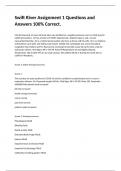Swift River Assignment 1 Questions and
Answers 100% Correct.
Charlie Raymond, 65-year-old male who was admitted to a negative pressure room on Med-Surg for
COVID precautions.. He has a history of COPD, hypertension, diabetes type II, and a recent
myocardial infarction. He is a retired postal worker who lives at home with his wife. He is on Claforan
(cefotaxime) 2 g IV q4hr and sliding scale insulin. Initially this cardiologist was concerned about
congestive heart failure and Mr. Raymond is receiving Furosemide (Lasix) 20 mg IV twice a day for
pulmonary edema. Vital Signs: BP is 145/78, Pulse 89 Respirations 24 and slightly labored,
Temperature 100.2 SaO2 94% on 2L nasal cannula. The patient/family is fearing the worst due to
COVID-19 Pandemic.
Scene 2: Select Nursing Concerns:
Scene 3
The next day, he tests positive for COVID 19 and his condition has deteriorated as he is now in
respiratory distress. Mr. Raymond weighs 260 lbs. Vital Signs: BP is 92/58, Pulse 102, Respiratio -
ANSWER-Educational need increased
fall risk increased
Health change increased
neuro normal
pain level normal
patient needs increased
Scene 2: Nursing concerns:
Physiological FALSE
Bleeding False
Death anxiety TRUE
Disturbed Body Image FALSE
Esteem FALSE
Impaired Acute Confusion FALSE
Impaired Gas Exchange TRUE
Ineffective breathing pattern TRUE
,Knowledge deficit TRUE
Pain, Acute FALSE
Physical Mobility, Impaired
Skin Integrity FALSE
Scene 7
Mr. Raymond, COVID-19 positive, in severe respiratory distress, rapid response called.
Patient has a history of COPD, hypertension, diabetes type II, and a recent myocardial infarction.
Patient received Furosemide Lasix 20mg, IVP x2, on Claforan Q4, and on sliding scale Insulin.
Intubated by RRT, BP: 88/58, P: 110, T: 101.2, SaO2: 94%, ABG's are pending. Foley catheter in place.
Recommend patient be transferred to ICU.
Accompany your
Lithia Monson, 93 years old, c/o head injury, r/o subdural hematoma. Hx of dementia, from nursing
home, fall one day ago. No known allergies (NKA). Vital signs -Temp 97.2, BP 96/74, P 82, RR 20,
SaO2 97%. Neuro- confusion to time and place, but oriented to self, speech clear, poor historian, did
not recognize son today which is new for her; Neuro assessment and vital signs q1 hr. Skin warm dry,
bruises on forehead with small laceration. Increased fall risk. DSD (dry sterile dressing), forehead
laceration clean and dry intact. 20ga. Hep-Lock in place left AC. GI WNL. Cardiovascular has pacer
with rate of 82bpm on demand. Strict I&O, regular diet, intake 50%. Waist belt restraint PRN; family
sitter at bedside, assist with bath. Dr. Altace - ANSWER-Educational increased
fall risk increased
health change increased
pain level normal
psych needs increased
sensorium increased
CC
Chanthavy Chhet, 46 y/o female admitted for dehydration and gastritis. She is accompanied by her
uncle who speaks fluent English, but patient speaks little to no English and is a Cambodian native.
The uncle suggests that nursing staff address the patient by CC. Family is concerned that she has not
been eating or drinking. Her non-verbal communication indicates abdominal discomfort. Vital signs
are: T: 99.4 F, 37.4 C, P:92, R:18, PaO2: 98%, BP: 102/82 sitting, BP: 90/64 standing
Scene 2: Acuity 3
, select appropriate concerns based on info:
Scene 3: CC's initial admitting orders include starting an IV D5 ½ NS at 100mL an hour, regular diet is
tolerated. Status board indicates that CC's lab work results have been populated. The following labs
are: HbG Hemoglobin: 9.1 g/dL (Female: 12 to 16 g/dL or 7.4 to 9.9 mmol/L (SI units) Hematocrit:
35% (Female: 37% to 47% or 0.37 to 0.47 volume fraction (SI units)) WBC: 11,150 - ANSWER-
educational needs Increased
fall risk increased
health change increased
neuro normal
pain level increased
Scene 3
Don appropriate PPE.
Change to simple O2 face mask per Healthcare provider
Perform focused respiratory assessment.
Notify respiratory therapist to begin treatment.
Notify family to self-isolate for 14 days
Scene 4
Reorient patient to setting using therapeutic communication.
Obtain a sitter/UAP.
Restart the IV.
Begin strict I&O.
Obtain an order to insert a foley catheter.
Scene 5
Use therapeutic communication to explain necessary procedure.
Position the patient properly.
Create sterile field with foley kit on the bedside table and don sterile gloves.
Instruct Lucy to assist in maintaining patient position and field sterility
Insert foley catheter according to hospital recommended guidelines,to ensure sterility of catheter.




